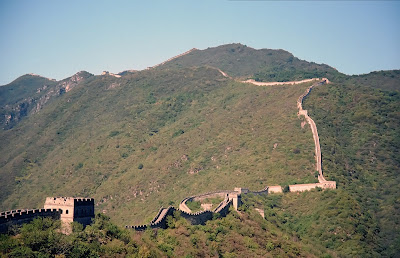Not "following" in a stalker sense, but avidly watching her three-part series Joanna Lumley's Trans-Siberian Adventure.
Anyone expecting her Absolutely Fabulous character Patsy to make a boozy appearance will be sorely disappointed. Instead, we see Joanna the traveller, experiencing the highs, lows and very often confusion that comes with travelling through foreign lands.
This series is captivating not only because the 6,300 mile journey she takes, but because it's the same journey my friend and I took a decade ago.
And while we continually hear that this part of the world is evolving at a rapid pace, what I find particularly engrossing is the fact that this journey hasn't changed at all since I took it.
There's fantastic little incidents that my friend and I experienced, such as being awoken in the middle of the night by angry Russian border guards, standing at the Chinese-Mongolian border in the middle of the night while the train is put onto a new rail gauge, and the seemingly endless amounts of vodka that is on offer for anyone venturing to this part of the world. Ten years on and Joanna is confronting the same thing.
Watching the TV series has also made me realise how much of the journey I had forgotten... temporarily. But seeing some of the sights of the three countries, even something as mundane as a house or train station, reconnected some of my brain's synapses.
 |
| Onboard the train one afternoon |
This trip was my second trip to Beijing and the Great Wall of China in two years. I even stayed at the same hotel in Beijing, though I noted it was surrounded by a lot more highrise towers than before.
The Beijing Olympics was still a few years away, but the city was quickly getting ready and residents were keen to brush up their English with any foreigner they could.
But once onboard the train and outside the cities, vast rural China spread out before us as we made tracks for Mongolia.
 |
| The streets of Beijing |
 |
| Inside the Forbidden City |
 |
| The Great Wall snaking its way across the landscape |
 |
| Heading across China on the train |
After the people and semi-ordered chaos of Beijing, the unpopulated expanses of Mongolia couldn't have been more of a contrast. Green fields soon dried out and became the Gobi Desert, where you hoped the train didn't break down.
At one stop at the town of Choir in Mongolia, there is a shining silver statue commemorating the first Mongolian cosmonaut. As I ran the several hundred metres from the train station to the statue to take a photo, I prayed the train wouldn't suddenly take off without me.
 |
| Mongolian cosmonaut statue in Choir |
 |
| The wide open spaces of Mongolia |
Another surprisingly stunning stop was over the Russian border in Siberia. Given the stories we hear about people being sent to Siberian gulags, I didn't have high expectations for this part of the world. I was wrong.
Among other things, Siberia is home to Lake Baikal, the largest freshwater lake in the world. It's believed the lake holds a fifth of the world's fresh water. I can also confirm that the water is very cold - we plunged into it after being in a sauna and it was literally breath taking.
 |
| Lake Baikal |
 |
| Traditional Siberian wooden buildings |
Finally in Moscow, we come face-to-face with some of the most iconic Russian sites: St Basil's Cathedral, the Kremlin and Lenin's tomb in Red Square. The capital feels imposing on many levels, not the least of which because the grand Soviet architecture can leave you feeling... well a little small.
 |
| Lenin's Tomb |
 |
| Former KGB headquarters |
 |
| The Kremlin |
 |
| The Hermitage Museum |
 |
| Church of the Saviour of Spilled Blood - St Petersburg's answer to Moscow's St Basil's Cathedral |








































.jpg)
.jpg)







